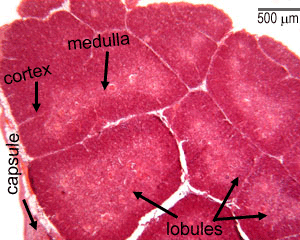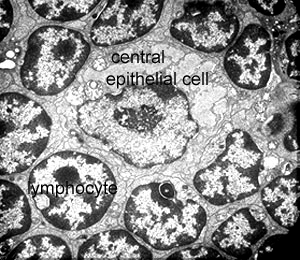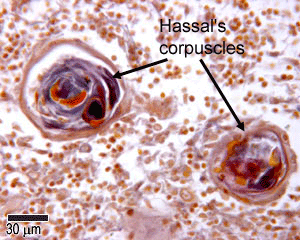Lymphoid tissue: T-lymphocytes and the Thymus
The thymus is a primary lymphoid organ found within
the superior mediatinum, behind the upper part of the sternum.
This organ is active in children, but at the start of puberty,
until old age, it starts to atrophy, producing fewer T-cells. The
thymus also produces thymic hormones that support the growth and
differentiation of T-cell progenitors.
It has two lobes divided up into many lobules. The outer, more
darkly staining region is the cortex, and this is highly cellular.
The inner lighter staining region is the medullar, and this region
is less cellular. It has an outer connective tissue capsule and
septa.
This organ is important for development of immunocompetent T-cells,
proliferation of clones of of mature T-cells, developing immunological
self-tolerance, and secretion of hormones for T-cell development.
At least three hormones are made: thymosin, thymulin and thymopoietin.
These hormones are produced by reticular epithelial cells in the
cortex.

The cortex stains more darkly (is more basophilic)
than the medulla, because it contains more lymphocytes than the medulla.
The epithelial network in the cortex is more finely branched than
in the medulla - and this gives this network the name 'reticular'.
The epithelial cells are connected to each other by desmosomes,
and the intermediate filament protein keratin is present in their cytoplasm.
This photograph shows a low power image of the thymus, showing
the more darkly staining cortex, and paler staining medulla. You
can also see the outer capsula, and the lobules.
This photograph shows part of the cortex and medulla at a higher magnification.
 Can you identify these two regions and the Hassal's corpuscle?
Can you identify these two regions and the Hassal's corpuscle?
At this magnification, you can't see individual lymphocytes,
but you can see Hassal's corpuscles in the medulla.
These are made up of flat non-secreting epithelial cells arranged
in a concentric layers that have keratinised. These structures are
only found in the thymus.
This photo, shows part of the thymus at higher magnification. It contains dividing cells (mitotic figures). Can you identify one?
The immature lymphocytes only differentiate in the cortex.
The T-cell progenitors proliferate in the outer cortex.
However, only 5% of the T-cells formed survive. The survivors are
the ones that can recognize self-MHC encoded surface glycoproteins,
i.e will be immunotolerant to antigen presenting cells from the same person.
Differentiating T-cells accumulate between epithelial reticular
cells. They can then pass into the venules and efferent lymphatics
along the border between the cortex and the medulla. Or they pass
into the medulla, where they are further selected by thymic dendritic
cells and matured before passing out of the medullary venules and
efferent lymphatics.
Blood from the inferior thyroid, and internal thoracic arteries
enters the thymus. The epithelial cells form a sheath around the
capillaries, to form a barrier to the entry of antigenic material
into the spaces between the epithelial cells in the reticular network.
This is known as the blood thymus barrier.
Further, the thymus only has efferent lymphatics, not afferent
lymphatics, to transport lymph and lymphocytes away from this organ.
The numerous darkly staining cells in this photo are the lymphocytes.  Can you identify them, and the capillaries?
Can you identify them, and the capillaries?

This is an electron micrograph of a reticular epithelial cell and surrounding lymphocytes.
The vast number of lymphocytes present make it difficult to see
the epithelial cells that both support them and may play a role
in their maturation. However, this electron micrograph shows the
close relationship between the central epithelial cell and the lymphocytes
surrounding it.

Hassal's corpuscles are thought to be degenerate epithelial
cells. They are made up of concentric layers of flattened reticular
epithelial cells filled with keratohyalin granules and keratin.

 Can you identify these two regions and the Hassal's corpuscle?
Can you identify these two regions and the Hassal's corpuscle? 
